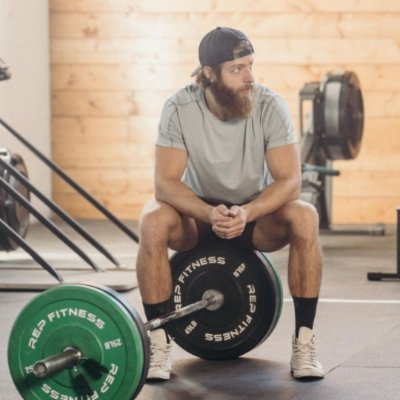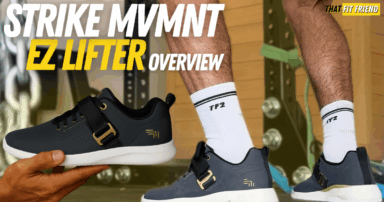That Fit Friend is supported by its readers. I [Jake Boly] run this site myself and buy the gear I review. If you purchase through my site, I may earn commissions on sales, read more here!
The Xero Shoes 360 is designed to tackle lifting, cross-training, and CrossFit-style workouts. As someone invested in the world of cross-training shoes and pushing models to their limits, I was curious about the Xero Shoes 360 and how they would hold up for this style of training.
Across the board, the 360 has been a pretty strong performer for lifting and CrossFit. Is it my favorite barefoot shoe for CrossFit? It’s an okay model, and it’s one of those shoes that steadily grows on you.
What do I mean by grow on you? Well, out of the box, the 360’s appearance can be so-so. However, I do think Xero has made a good effort to roll out more aesthetic colorways over the last two years.
On top of this, the 360 is sneaky good for transcending its primary niches. For example, you can use this shoe as a barefoot court shoe if you want a single shoe for your court sports and gym workouts. In that lens, the 360 slaps (as the youngins say).

Who Should Invest In the Xero Shoes 360?
The Xero Shoes 360 has proven to be a great option for cross-training for those who love barefoot shoes and want to experiment more with this style of footwear for their cross-training and CrossFit workouts.
They’re plenty stable for heavy lifting and didn’t compress whatsoever when I deadlifted over 500 lbs in them and power cleaned 275 lbs. The removable insole is also a perk for athletes that want a little variety in regard to how this feels.
For general cross-training, this shoe’s upper also does a fairly good job from a durability standpoint. The one area where it does fall a little short is for high-volume rope climbs so definitely keep an eye on this if you’re investing in this shoe specifically for CrossFit.
If you’re into cross-training and CrossFit and want to get more into barefoot shoes, then I think the Xero Shoes 360 could be a good option to explore.
Xero Shoes 360 Pros
For training and daily wear, I’ve found a handful of pros that I really like about the Xero Shoes 360.
- Upper Construction Is Fairly Durable
- Sole Works Well for Multi-Directional Training
- Removable Insole Is Great for Heavy Lifting
- Wide Toe Box Is Good for Toe Splay
The first pro with the Xero Shoes 360 is their more durable upper construction. The Xero Shoes Prio and HFS both feature a lighter mesh upper, so to combat friction in the 360, this model features rubber inlays over the toe box and lower midfoot.

For the most part, the upper does a good job at resisting general abrasion that you’ll run into during cross-training workouts. The only area where this model’s durability can fall a little short is with high-volume rope climbs which I’ll discuss more on below.
Another pro with the Xero Shoes 360 is the sole which features tread for multiple-directional activity. If you’re planning to do lateral movements or activities like plyometrics where tread is important, then this model’s sole does a good job at promoting overall traction.

Like most training-focused Xero Shoes, the insole in the 360 also comes out and the internal part of the shoe is finished. This is great for two key reasons. First, it gives you a little variety in the cushion you want.
Second, it’s great for deadlifts, squats, and other lower body movements when gripping the floor is essential and you want a super minimalist feel with your shoes.
The last Xero Shoes 360 pro is the wider toe box. If you love having room to splay the toes and feel the ground, then you’ll like how wide this shoe’s toe box is.
This is a pretty standard sizing feature in barefoot shoes, but in the context of cross-training shoes, the 360 could be a good option to explore if you have wider and flatter feet and want a more minimalist-style shoe.

Xero Shoes 360 Cons
In regard to training, I do think there are a couple of areas in which the Xero Shoes 360’s construction falls short.
- Upper Durability Can Be Hit or Miss for Rope Climbs
- Avoid Concrete On the Front Mesh
- Toe Can Look Clunky for Daily Wear
The first potential drawback I could see others having with the 360 is that their upper durability can be a little problematic with a lot of rope climbing. For the most part, the rubber inlays do a good job at preventing abrasion, but I did start to notice one of them peeling off on my right shoe.

This lipping of the rubber inlay came after using these shoes for a few months and being pretty rough on them. While I don’t think this will be an immediate issue for most athletes it’s certainly something to keep an eye on if you’re using this shoe for a lot of rope climbing.
Another potential drawback that I could see others having with this model is that the front mesh can scuff pretty fast on concrete. I played a few hours of pickleball in these and drug my toes saving a few shots and the mesh scuffed pretty bad.

This isn’t a huge concern for many by any means because concrete friction is very rare unless you’re training hard outside and programming prone to get-up work or playing certain sports, but it’s still food for thought for anyone training outside.
In regard to lateral movement, this shoe has been solid and it’s only been the direct toe dragging that has caused the scuffing of the toe box’s toe guard mesh layer.

The final drawback that I have with the Xero Shoes 360 is the toe’s appearance. For daily wear, the toe box of this shoe can look thick and clunky which is a knock on how versatile this shoe can be in different settings.
Performance
To discuss the Xero Shoes 360’s performance, I’m going to break down how this model performs in a variety of settings including CrossFit, cross-training, lifting, HIIT, and short runs.
This way you can hopefully better contextualize if this shoe is a good fit for your training wants needs and wants before investing.

Testing the Xero Shoes 360 for Lifting and CrossFit
For lifting, I personally really like these shoes, and are among some of my barefoot workout shoes. They provide adequate width in the toe box so I think most will enjoy how easy it is to splay the toes in this shoe.
In the context of lower body training and deadlifting, I think the two main callouts to like about this model are its sole construction and the fact that you can take the insole out. When deadlifting, I take the insole out to get closer to the floor and increase the ground feel I get with this shoe.

I’ve deadlifted well over 500 lbs in this model on multiple occasions and every time it does an exceptional job with stability. For lower body training, the sole articulates well and provides adequate traction on a variety of surfaces. The 360 sole wrap is a nice touch for adding to this shoe’s traction.
In the context of CrossFit, this shoe does a pretty good job, especially when compared to other barefoot shoes. The toe guard does a pretty good job at protecting the toes from burpees and if you’re only training indoors, then it should do a pretty good job in regard to its durability.

When catching cleans, this shoe is pretty comfortable and the sole articulation is nice for things like box jumps, double-unders, and high-volume dumbbell and kettlebell work.
The upper is hit or miss once again for rope climbs. I think it could be better for the next updated iteration. It would be nice to have a little more material around the midfoot and potentially more material to promote how this shoe bites the rope.

Testing the Xero Shoes 360 for Plyometrics, Agility, and HIIT
With this style of training, I can’t stress enough that you will need to acclimate to barefoot shoes if you’ve never worn them. The higher ground impact forces with jumping and HIIT can feel comfortable when starting out, but once you acclimate I think you’ll like this shoe.

The insole and sole actually feel a bit more responsive than the HFS and Prio which somewhat surprised me and could just be mental, to be honest. I noticed this most when doing various plyometrics.
And maybe this is a placebo, but I think the reworked 360 sole construction actually gave this model a slightly more responsive and reactive feel when doing plyometric and athletic-focused training.

For track workouts and my athletic-focused sessions, the sole’s traction and upper’s breathability are among some of my favorite features of this model. You can wear this model outdoors and indoors for versatile training and get a lot out of its construction.
Testing the Xero Shoes 360 for Running and Daily Wear
For running, the Xero Shoes 360 feels pretty standard for most barefoot shoes, and they perform similar to the Zelen and HFS for short runs. Their multi-directional sole gives them a nice little extra feeling of traction on different surfaces.

Plus, the removable insole is a nice feature for giving you a little more cushion. Personally, I think this model will perform best for athletes that plan to use these shoes for lifting and for runs that are around 3-miles or less.
If you plan to run longer distances, then you may want to explore a more running-focused barefoot shoe. For daily wear, the Xero Shoes 360 works well, however, I’m not the biggest fan of this shoe’s appearance.

While some enjoy the look of the 360, I think it can look a little clunky and dated and isn’t the best for more formal daily wear. If you just plan to wear them to run errands, for walking, or around the house, then you’ll enjoy what the 360 has to offer.
Xero Shoes 360 Sizing
For most athletes and lifters, you should be safe going true-to-size in the Xero Shoes 360. Their toe box is plenty wide for those with flatter feet and their length fits very true and snug.
Do note, that barefoot shoes have less material for mid-foot support, but I do think that’s something most adapt to with acclimating to this style of footwear. This aspect is something to stay conscious of when you’re purchasing barefoot shoes for the first time.
- Xero Shoes Sizing Thoughts: Go true to size.

If you have additional questions on the Xero Shoes 360 sizing or how they compare to other barefoot shoes, drop a comment below and I can try to help you out accordingly.
Construction Details
If you’re interested in the construction details of the Xero Shoes 360, I’ve pulled what I think are the most important for this model.
- Heel-to-Toe Drop: 0mm
- Weight: 10.2 oz (for a size 10 with the removable insole)
- Eyelets: 6 (one for lace-lock)
- Huarache-Style Security
- External Rubber Upper Counters
- Wider Toe Box With Mesh Cover
- Multi-Directional Rubber Sole
If you have any additional questions about the Xero Shoes 360’s construction, drop a comment below.
Takeaway Thoughts
The Xero Shoes 360 are quickly becoming one of my favorite barefoot training shoes. They’re plenty stable for my powerlifting-focused workouts and can also tackle the versatile cross-training sessions I implement on a weekly basis.
My only gripe with this shoe is that you can run into long-term durability issues with them here and there if you’re doing a lot of rope climbing and outdoor training where there’s friction on the upper.
If you have any questions about this model, drop a comment below or reach out to me personally via Instagram (@jake_boly)!







Dave
I’m looking for a pickleball shoe and heard good things about the 360s. Issue is; I have a medium width forefoot(per store measurement device), low volume mid foot and narrow heel. I’ve tried the Hana in women’s which xero recommended and it kinda fit but I could feel the edge/overflow on the side of the sole sometimes and it sometimes felt too narrow.
I have inov-8 f-245s which are pretty good negative would be stops and semi-lateral movements can have some slide inside the shoe and big toe curve on the shoe seems to push a little inward on my big toe. I have Whitin casual sneakers with a little insole fit is good, it will probably wear out quickly and the heel collar padding could be better. Any recommendations?
Hey! 360 may be worth trying first, imo. If you want a training shoe, then you may like the Inov-8 F-Lite 235 V3 as they feel a little more minimalist!
Kevin
I’ve gone through a bunch of your videos in my search for crossfit-appropriate shoes for very WIDE feet (toe area). The Xero 360 seems like the best option for me?? I’m a bit nervous to be all-in on 0mm shoes for training but I like to take walks in barefoot shoes.. I’d be willing to buy a couple different shoes if one shoe lacks for a particular workout or for a wide 4mm drop option, but for me I’m prioritizing the widest available toebox as most important for most workouts.
I’ve been locked in on Reebok nano’s for years, but current models are too narrow for me – I’ve got 2 pairs of nano X upsized by 1/2 size and can’t use in gym.. and I don’t want to go above 4mm drop. My actual measured size is 7-1/2 4W, but my *normal size is 8-1/2 to make width work, and my nano X’s are 9’s – so uncomfortable. I’m tired of pinky toe being crushed!!!
So frustrating no company makes a 2W or 4W option for crossfit-style workouts.. would you recommend any others?
Hey Kevin — honestly, I feel that. IMO, it’s a MASSIVE missed opportunity for companies not to make wider models for CrossFit/cross-training.
The 360 is a viable option, it’s not a bombproof option, though. On top of cross-training shoes lacking, I also feel as though minimalist shoes are still in their infancy stage when it comes to CrossFit shoes. I wouldn’t be too concerned with the 0mm drop, but more so, the difference in cushion that you’d get with he 360 from a Nano. The acclimation process can be tedious, especially for WODs with more plyos/running.
Check out the UA TriBase Reign 4, they have a 2mm drop and have a decent width through the their forefoot. The Haze Trainer can also be a viable option when it comes to width (note, the toe box upper is pretty low volume).